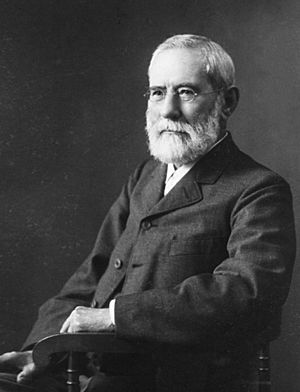Oswald Schmiedeberg facts for kids
Quick facts for kids
Johann Ernst Oswald Schmiedeberg
|
|
|---|---|
 |
|
| Born | 10 October 1838 |
| Died | 12 July 1921 (aged 82) |
| Alma mater | University of Dorpat |
| Scientific career | |
| Influences |
|
Johann Ernst Oswald Schmiedeberg (born October 10, 1838 – died July 12, 1921) was an important scientist from the Baltic German region. He was a pharmacologist, which means he studied how medicines and other chemicals affect the body.
In 1866, he earned his medical degree from the University of Dorpat. His research focused on measuring chloroform in blood. Later, he became the very first professor of pharmacology at the University of Strasbourg. He worked there for an amazing 46 years!
Schmiedeberg played a huge role in the success of the German pharmaceutical (medicine-making) industry. He trained many of the professors who taught pharmacology in Europe at that time.
Contents
Early Life and Education
Oswald Schmiedeberg was born in Courland, which was a part of Russia back then. His father, Wilhelm Ludwig, was a bailiff and later a forester. His mother, Anna Lucie Bernard, was the daughter of a watchmaker.
Oswald was the oldest of six children. He went to primary school in Permisküla and then to a gymnasium (a type of high school) in Dorpat. After that, he joined the medical school at the University of Dorpat.
Schmiedeberg's Career and Discoveries
In 1866, Oswald Schmiedeberg completed his medical degree. His main project was about "Determination and Concentration of Chloroform in the Blood." This was a study on how much chloroform was in the blood.
He then worked as an assistant to Rudolf Buchheim at Dorpat (now called Tartu) until 1869. For one year, he also worked with Carl Ludwig at the University of Leipzig.
In 1872, Schmiedeberg made history by becoming the first professor of pharmacology at the University of Strasbourg. He stayed there for 46 years, teaching and doing research.
Key Research Areas
Schmiedeberg's work mostly focused on how different chemicals affected the body. He studied:
- Chemicals that were poisonous to the heart.
- Substances that caused vomiting.
- Chemicals that made people pass urine.
- Hypnotics, which are substances that help people sleep.
- Various venoms and metals.
Important Discoveries
With his student Hans Horst Meyer, Schmiedeberg found glucuronic acid. This acid helps the body get rid of harmful substances. They later learned that glucuronic acid is also a part of cartilage (the flexible tissue in your body). It is also found in chondroitin sulfate.
He also studied hyaluronic acid and how it relates to collagen and other body components. In 1869, he showed that muscarine (a substance found in some mushrooms) affects the heart in a way similar to stimulating the vagus nerve. He also proved that urethane could make people sleepy.
Influence on Industry
Schmiedeberg was very important for the German pharmaceutical industry before World War II. He trained many of the professors who then taught pharmacology across Europe. This helped Germany become a leader in making medicines.
He wrote over 200 scientific books and articles. He also helped start a science journal called Naunyn-Schmiedeberg's Archives of Pharmacology. He did this with two pathologists, Bernhard Naunyn and Edwin Klebs.
Later Life and Legacy
Oswald Schmiedeberg's health slowly declined. He passed away at the age of 82 in Baden-Baden. His work left a lasting impact on the field of pharmacology.
Selected Publications
Schmiedeberg wrote many important scientific works. Here are a few examples:
- Ueber die quantitative bestimmung des Chloroforms im Blute und sein Verhalten gegen dasselbe (1866) – This was about measuring chloroform in the blood.
- Das Muscarin. Das giftige Alkaloid des Fliegenpilzes (Agaricus muscarius L.) seine Darstellung, chemischen Eigenschaften, physiologischen Wirkungen, toxicologische Bedeutung und sein Verhältniss zur Pilzvergiftung im allgemeine (1869) – This book focused on muscarine, a poisonous substance from the fly agaric mushroom. It explained its properties and effects.
- Grundriss der Arzneimittellehre (1883) – This book covered the basics of pharmacology.
- Grundriss der Pharmakologie in Bezug auf Arzneimittellehre und Toxikologie (1902) – This book was a guide to pharmacology, including how medicines work and the study of poisons.
See also
 In Spanish: Oswald Schmiedeberg para niños
In Spanish: Oswald Schmiedeberg para niños

